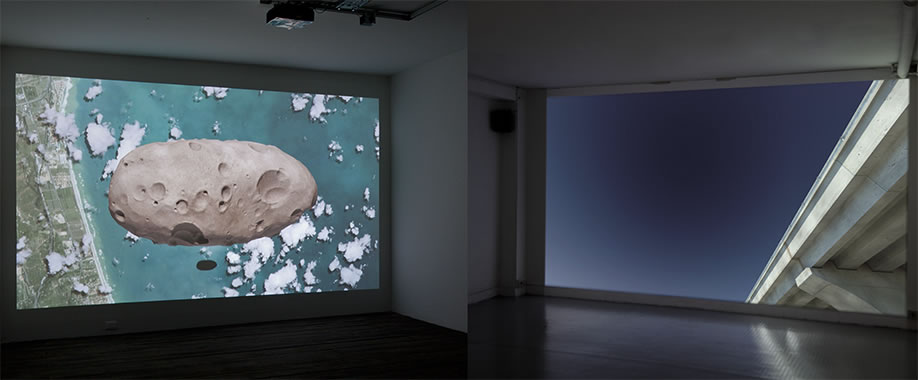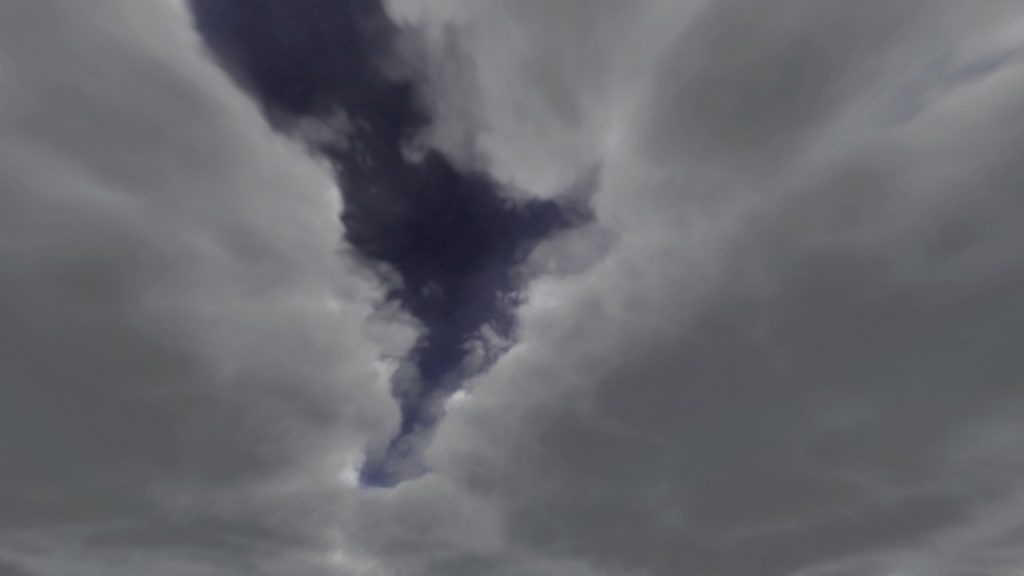non c’è suspense, né morale, né cause ed effetti

non c’è suspense, né morale, né cause ed effetti, 2010
two channel HD video installation, 3d computer graphics, stereo sound.
La frase che dà il titolo a questo progetto è una citazione dal romanzo Mattatoio n.5 di Kurt Vonnegut: “Non c’è principio, parte di mezzo o fine, non c’è suspense, né morale, né cause ed effetti.” Questa frase può essere intesa come il leitmotiv del mondo naturale e biologico, del modo in cui esso si sviluppa e manifesta. La videoinstallazione a due canali, pone l’accento sul senso di attesa e incombenza (dal latino incumbere, posare sopra) che la natura a volte suscita. Essa risponde solo al caso e alla propria necessità, è per definizione imprevedibile e come tale, incombente su di noi.
La videoinstallazione collega in un’unica esperienza i due ambienti della galleria, comunicanti mediante una scala. La lenta rotazione dell’asteroide al piano terra ha come traccia audio registrazioni effettuate tramite microfoni di profondità negli abissi dell’oceano Atlantico e Pacifico. Nel piano interrato il sonoro è composto dalla rielaborazione (per renderle udibili) delle onde radio captate nello spazio da alcune delle sonde inviate dalla NASA su pianeti remoti del nostro sistema solare.
Il primo video è uno sguardo che dall’alto scruta verso il basso, mostrando parti più o meno definite della superficie terrestre, mentre al piano inferiore le inquadrature hanno visuale dal basso verso l’alto. Percorrendo la scala che unisce i due spazi, sentiamo le due tracce audio confondersi e gli sguardi delle due proiezioni, almeno idealmente, si incrociano.
Le registrazioni sottomarine utilizzate sono molto diffuse e peculiari per non essere ancora state con certezza identificate. Si tratta di suoni catturati spesso da postazioni molto distanti, anche ai capi opposti dell’oceano. Ciò fa supporre fenomeni di portata molto ampia ma le cause di queste onde sonore restano sconosciute. Al contrario, le emissioni radio spaziali registrate nelle vicinanze di Giove e Saturno dalle sonde Voyager e Cassini, sono identificate con precisione e corrispondono a fenomeni naturali come aurore boreali o passaggi attraverso il campo magnetico di un pianeta, confrontabili ed assimilabili ad analoghi fenomeni già rilevati sulla terra.
The title of this work is a quotation from Slaughterhouse Five, a novel by Kurt Vonnegut. “There is no beginning, no middle, no end, no suspense, no moral, nor causes, no effects.” This sentence can be used as a leitmotiv for the biological and natural world development. The dual channel video installation emphasizes on the waiting and impending awareness that nature can arouse sometimes. It answers only to randomness and to its own needs, it’s erratic and unpredictable, incumbent on us (from Latin, present participle of incumbere, to lean upon).
The video installation is staged in two rooms, connected by a staircase. The soundtrack of the slow asteroid rotation on the first floor is a series of scientific sound recordings taken with underwater hydrophones in the Atlantic and Pacific oceans. In the basement floor, the audio track is composed of re-processed radio waves recorded by NASA deep-space probes orbiting around remote planets of our Solar System.
The first video has high-angled shots, from Space to Earth, showing various cuts from the Earth surface, while the basement video is composed of low angle shots, looking upwards, from the Earth to the sky. On walking down the stairs that connect the floors, the audio tracks merge and blend together, so that, at least ideally, these two opposite shots intersect each other.
The deep-water recordings used here are known because they haven’t been identified yet. These sounds are often captured by hydrophones placed at great distances from one another, even at opposite ends of the Pacific Ocean. In time, this has led to assumptions on the large-scale origin of this still unknown phenomenon. On the contrary, the radio emissions recorded near Jupiter and Saturn by Voyager and Cassini deep-space probes were identified with utter precision: they had to do with natural events such as aurora borealis or passages through the magnetic field of a planet, comparable to known terrestrial phenomena.

